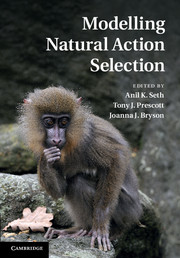Book contents
- Frontmatter
- Contents
- Foreword
- Preface
- Contributors
- 1 General introduction
- Part I Rational and optimal decision making
- Part II Computational neuroscience models
- Part III Action selection in social contexts
- 18 Introduction to Part III: action selection in social contexts
- 19 Agent-based models as scientific methodology: a case study analysing the DomWorld theory of primate social structure and female dominance
- 20 An agent-based model of group decision making in baboons
- 21 Endogenous birth and death of political parties in dynamic party competition
- 22 On optimal decision making in brains and social insect colonies
- 23 State-dependent foraging rules for social animals in selfish herds
- Index
- Plate section
- References
22 - On optimal decision making in brains and social insect colonies
from Part III - Action selection in social contexts
Published online by Cambridge University Press: 05 November 2011
- Frontmatter
- Contents
- Foreword
- Preface
- Contributors
- 1 General introduction
- Part I Rational and optimal decision making
- Part II Computational neuroscience models
- Part III Action selection in social contexts
- 18 Introduction to Part III: action selection in social contexts
- 19 Agent-based models as scientific methodology: a case study analysing the DomWorld theory of primate social structure and female dominance
- 20 An agent-based model of group decision making in baboons
- 21 Endogenous birth and death of political parties in dynamic party competition
- 22 On optimal decision making in brains and social insect colonies
- 23 State-dependent foraging rules for social animals in selfish herds
- Index
- Plate section
- References
Summary
Summary
The problem of how to compromise between speed and accuracy in decision making faces organisms at many levels of biological complexity. Striking parallels are evident between decision making in primate brains and collective decision making in social insect colonies: in both systems separate populations accumulate evidence for alternative choices, when one population reaches a threshold a decision is made for the corresponding alternative, and this threshold may be varied to compromise between the speed and accuracy of decision making. In primate decision making simple models of these processes have been shown, under certain parameterisations, to implement the statistically optimal procedure that minimises decision time for any given error rate. In this chapter, we adapt these same analysis techniques and apply them to new models of collective decision making in social insect colonies. We show that social insect colonies may also be able to achieve statistically optimal collective decision making in a very similar way to primate brains, via direct competition between evidence-accumulating populations. This optimality result makes testable predictions for how collective decision making in social insects should be organised. Our approach also represents the first attempt to identify a common theoretical framework for the study of decision making in diverse biological systems.
Introduction
Animals constantly make decisions. Habitat selection, mate selection, and foraging require investigation of, and choice between, alternatives that may determine an animal's reproductive success. For example, many animals invest considerable time and energy in finding a safe home (Franks et al., 2002; Hansell, 1984; Hazlett, 1981; Seeley, 1982). Similarly an animal may frequently have to deal with ambiguous sensory information in deciding whether a predator is present or not (Trimmer et al., 2008).
- Type
- Chapter
- Information
- Modelling Natural Action Selection , pp. 500 - 522Publisher: Cambridge University PressPrint publication year: 2011

